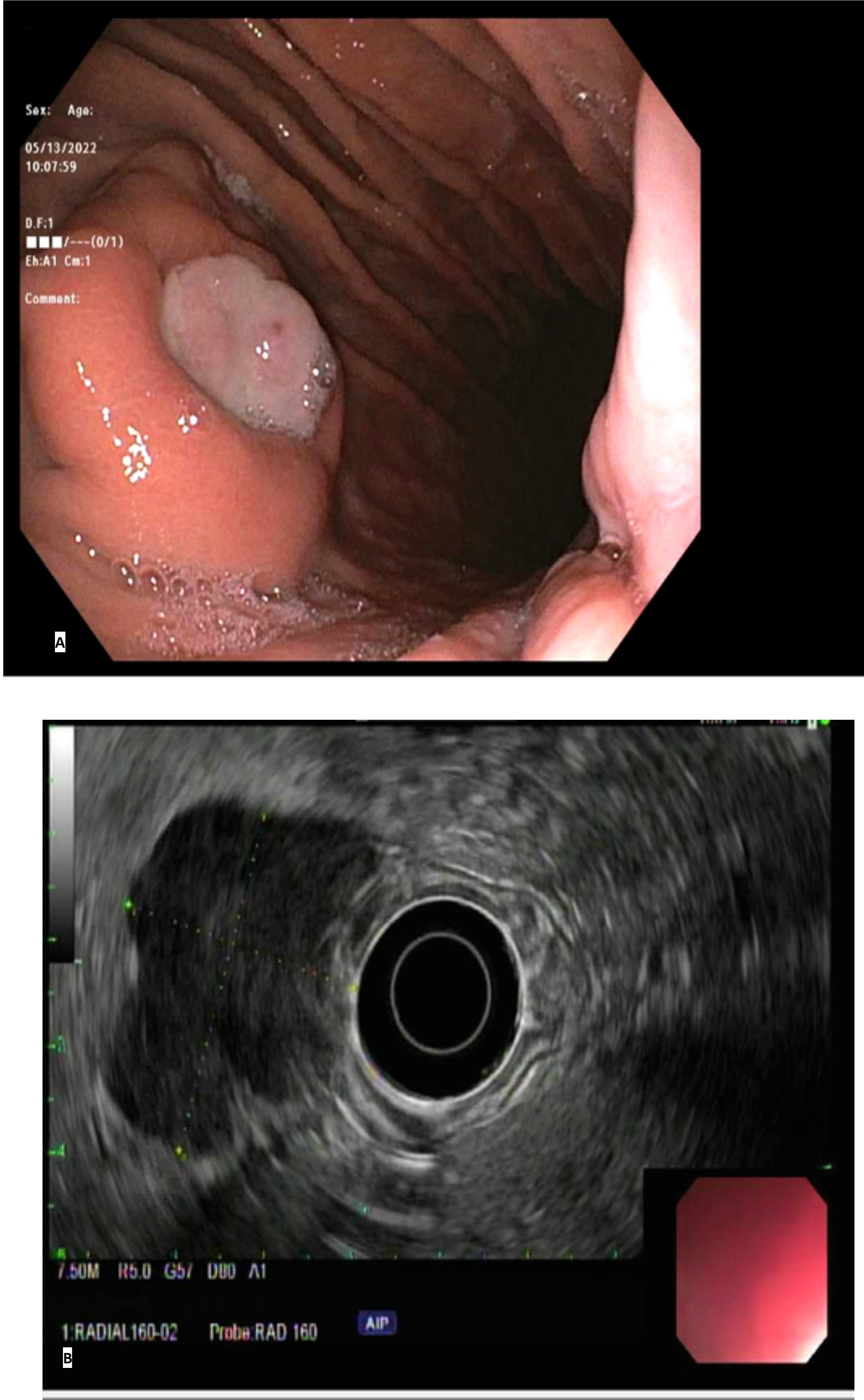Back


Poster Session D - Tuesday Morning
Category: Stomach
D0696 - Unusual Stomach Mass: Gastric Metastasis of Malignant Leiomyosarcoma
Tuesday, October 25, 2022
10:00 AM – 12:00 PM ET
Location: Crown Ballroom

Has Audio

Samiksha Pandey, MBBS
William Beaumont Hospital
Royal Oak, MI
Presenting Author(s)
Rabin Neupane, MD1, Samiksha Pandey, MBBS2, Shailesh Niroula, MBBS3, Michael Cannon, MD1
1Beaumont Hospital, Royal Oak, MI; 2William Beaumont Hospital, Royal Oak, MI; 3Beaumont Health, Royal Oak, MI
Introduction: Metastases in the stomach are rare findings, and likely represent a progressive malignant disease. With reported incidence of 0.2%-0.7%, the tumor can spread through hematogenous, lymphatic direct and peritoneal dissemination. Gastric metastases of leiomyosarcoma (LMS), a rare malignant mesenchymal smooth muscle tumor, have only been documented in a handful of case reports. We present a case of metastatic leiomyosarcoma in the stomach presenting with gastrointestinal bleeding.
Case Description/Methods: A 64-year-old male with history of metastatic LMS of his left lower extremity came with melena for 3 days. Hemoglobin on presentation was 8.7 g/dl from his baseline of 13-14g/dl. He was diagnosed with grade 3 LMS 3 years ago, involving femoral vessel wall and muscle of his left thigh. He underwent radical excision without any adjuvant chemo and radiotherapy despite recommendations. He subsequently developed metastasis to the lung two years later at which time he started chemotherapy.
An esophagogastroduodenoscopy revealed a 6mm mucosal nodule and a 3 cm mass with a clean based ulcer in the body of stomach. Biopsy, however, was negative for malignancy. He then underwent endoscopic ultrasound guided biopsy for cytology which revealed malignant spindle cell neoplasm in the background of lymphoid tissue consistent with metastatic LMS.
Discussion: LMS, a malignant tumor of smooth muscle origin, represents 20%-30% of soft tissue sarcomas. Predominantly uterine in origin, it can arise from the peritoneum, extremities, and blood vessels. Primary gastric LMS has also been reported in literature, but they are extremely rare and now are considered a type of gastrointestinal stromal tumor. LMS has a rapid tendency to metastasize, with lung, peritoneum, bone, and liver being common targets. Some rare cases of LMS metastasizing to pancreas, stomach and oral cavity have been reported.
In general, metastases to the stomach are uncommon. The most common gastric metastases come from breast, lung, renal cell cancer and malignant melanoma. Metastasis of LMS to gastric mucosa has been limited to only a handful of case reports with primary tumors arising from kidney, uterus, and broad ligaments. The lesions are described as nodules, submucosal tumors, and ulcerative lesions, most of which are asymptomatic but can present as GI bleeding and abdominal pain. These metastases typically portray a poor prognosis. Local excision of the primary lesion with hormonal therapy and chemotherapy is considered standard treatment.

Disclosures:
Rabin Neupane, MD1, Samiksha Pandey, MBBS2, Shailesh Niroula, MBBS3, Michael Cannon, MD1. D0696 - Unusual Stomach Mass: Gastric Metastasis of Malignant Leiomyosarcoma, ACG 2022 Annual Scientific Meeting Abstracts. Charlotte, NC: American College of Gastroenterology.
1Beaumont Hospital, Royal Oak, MI; 2William Beaumont Hospital, Royal Oak, MI; 3Beaumont Health, Royal Oak, MI
Introduction: Metastases in the stomach are rare findings, and likely represent a progressive malignant disease. With reported incidence of 0.2%-0.7%, the tumor can spread through hematogenous, lymphatic direct and peritoneal dissemination. Gastric metastases of leiomyosarcoma (LMS), a rare malignant mesenchymal smooth muscle tumor, have only been documented in a handful of case reports. We present a case of metastatic leiomyosarcoma in the stomach presenting with gastrointestinal bleeding.
Case Description/Methods: A 64-year-old male with history of metastatic LMS of his left lower extremity came with melena for 3 days. Hemoglobin on presentation was 8.7 g/dl from his baseline of 13-14g/dl. He was diagnosed with grade 3 LMS 3 years ago, involving femoral vessel wall and muscle of his left thigh. He underwent radical excision without any adjuvant chemo and radiotherapy despite recommendations. He subsequently developed metastasis to the lung two years later at which time he started chemotherapy.
An esophagogastroduodenoscopy revealed a 6mm mucosal nodule and a 3 cm mass with a clean based ulcer in the body of stomach. Biopsy, however, was negative for malignancy. He then underwent endoscopic ultrasound guided biopsy for cytology which revealed malignant spindle cell neoplasm in the background of lymphoid tissue consistent with metastatic LMS.
Discussion: LMS, a malignant tumor of smooth muscle origin, represents 20%-30% of soft tissue sarcomas. Predominantly uterine in origin, it can arise from the peritoneum, extremities, and blood vessels. Primary gastric LMS has also been reported in literature, but they are extremely rare and now are considered a type of gastrointestinal stromal tumor. LMS has a rapid tendency to metastasize, with lung, peritoneum, bone, and liver being common targets. Some rare cases of LMS metastasizing to pancreas, stomach and oral cavity have been reported.
In general, metastases to the stomach are uncommon. The most common gastric metastases come from breast, lung, renal cell cancer and malignant melanoma. Metastasis of LMS to gastric mucosa has been limited to only a handful of case reports with primary tumors arising from kidney, uterus, and broad ligaments. The lesions are described as nodules, submucosal tumors, and ulcerative lesions, most of which are asymptomatic but can present as GI bleeding and abdominal pain. These metastases typically portray a poor prognosis. Local excision of the primary lesion with hormonal therapy and chemotherapy is considered standard treatment.

Figure: A. Endoscopic appearance of the metastatic LMS as a gastric body mass with clean based ulcer
B. Endosonographic image of the mass in the gastric image
B. Endosonographic image of the mass in the gastric image
Disclosures:
Rabin Neupane indicated no relevant financial relationships.
Samiksha Pandey indicated no relevant financial relationships.
Shailesh Niroula indicated no relevant financial relationships.
Michael Cannon indicated no relevant financial relationships.
Rabin Neupane, MD1, Samiksha Pandey, MBBS2, Shailesh Niroula, MBBS3, Michael Cannon, MD1. D0696 - Unusual Stomach Mass: Gastric Metastasis of Malignant Leiomyosarcoma, ACG 2022 Annual Scientific Meeting Abstracts. Charlotte, NC: American College of Gastroenterology.
